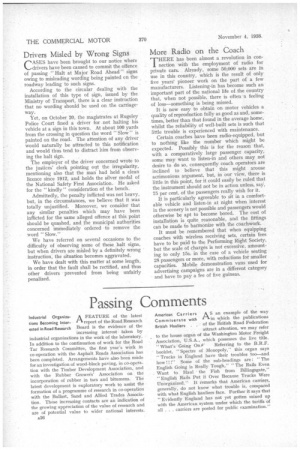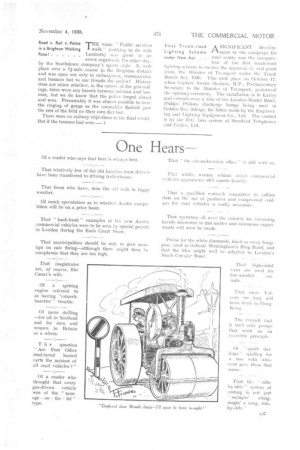Passing Comments
Page 28

Page 29

If you've noticed an error in this article please click here to report it so we can fix it.
Industrial OrganizaA FEATURE of the latest tions Becoming Interreport of the Road Research ested in Road Research Board is the evidence of the
increasing interest taken by industrial organizations in the work of the laboratory. In addition to the continuation of work for the Road Tar Research Committee, the first year's work in co-operation with the Asphalt Roads Association has been completed. Arrangements have also been made for an investigation of wood-block paving, in co-operation with the Timber Development Association, and with the Rubber Growers' Association on the incorporation of rubber in tars and bitumens. The latest development is exploratory work to assist the formation of a programme of research in co-operation with the Ballast, Sand and Allied Trades Association. These increasing contacts are an indication of the growing appreciation of the value of research and are of potential value to wider national interests.
American Carriers A S an example of the way Commiserate with I-1 in which the publications British Hauliers . . of the British Road Federation
attract attention, we may refer to the house organ of the Washington Motor Freight Association, U.S.A., which possesses the live title.
"What's Going OriA' Referring to the B.R.F. booklet, "Spectre of Monopoly," this organ says "Trucks in England have their troubles too—and how I !" Some of the sub-headings are : "The English Going is Really Tough," "The Rails Even Want to .Haul • the Fish from Billingsgate," "English Rails Put it Over Because Trucks Were Unorganized." It remarks that American carriers, generally, do not know what trouble is, compared with what English hauliers face. Further it says that "Evidently England has not yet gotten mixed up with the American system under which the tariffs of all . . . carriers are posted for public examination." THE name "Public services walk " (nothing to do with Lambeth) was given to an event organized, the other day, by the Southdown company's sports club. It took place over a 7i-mile course in the Brighton district and was open not only to railwaymen, tramwaymen and busmen but to our friends the police! History does not relate whether, in the course of the proceedings, there were any brawls between railmen and busmen, but we do know that the police forged ahead and won. Presumably it was almost possible to hear the ringing of gongs as the constables flashed past the rest of the field on their own flat feet.
There were no railway objections to the final result.
But if the busmen had won
Road v. Rail v. Police in a Brighton Walking Race!
A SIGNIFICANT develop ment in the campaign for road safety was the inauguration of the first trunk-road lighting scheme to receive the approval of, and grant from, the Minister of Transport under the Trunk Roads Act, 1936. This took place on October 17, when Captain Austin Hudson, M.P., Parliamentary Secretary to the Minister of Transport, performed the opening ceremony. The installation is in Earley and extends over a mile of the London-Bristol Road, Philips Philora discharge lamps being used in Golden Ray fittings, the latter made by the Engineering and Lighting Equipment Co., Ltd. The control is by the D.C. bias system of Standard Telephones and Cables, Ltd.
First Trunk-road Lighting Scheme under New Act . .




















































































